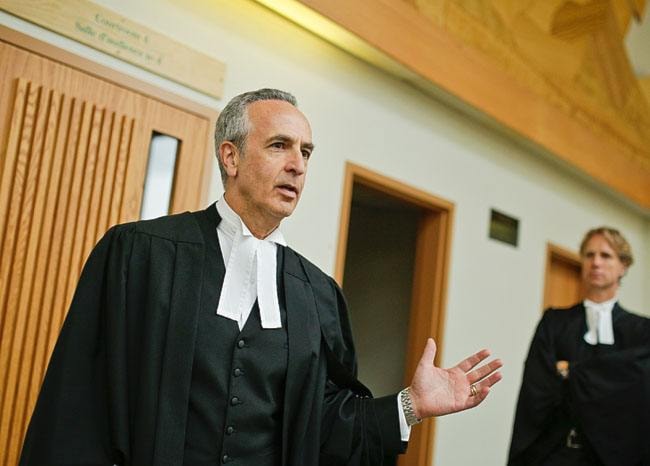While protesters stood outside Whitehorse’s law courts yesterday in the soggy weather and took part in a ceremony honouring the Yukon’s various waterways, inside the courtroom the central issue was comparably dry.
The case before the Court of Appeal could help determine the fate of the Peel watershed, a 68,000 square kilometre piece of northeast Yukon. But the arguments heard by the judges focus on the interpretation of one small section of the Yukon’s Umbrella Final Agreement with First Nations.
The case pits First Nations - Nacho Nyak Dun, Tr’ondek Hwech’in and now the Vuntut Gwitchin - as well as the Yukon Conservation Society and the Yukon chapter of the Canadian Parks and Wilderness Society against the Yukon government.
While the government brought in an experienced Toronto-based legal team, the plaintiffs are represented by renowned aboriginal law pioneer Thomas Berger.
A crowd gathered to see the two sides square off, with nearly 100 spectators crammed into two courtrooms to watch the proceedings either in person or via video feed down the hall.
Last year Yukon Supreme Court Justice Ron Veale ruled the Yukon government overstepped when, after many years of talks, it disregarded a planning commission’s recommendations to protect 80 per cent of the watershed from development. Instead, the government’s plan protected only 29 per cent from new mineral staking.
After the loss, the Yukon government decided to appeal.
The big question is whether the government had the authority to come up with the plan it did, or whether doing so flouted the government’s responsibilities under the UFA.
Government lawyers returned to many of the same themes from the original trial. They pointed to the section of the UFA that allows government to accept, reject or modify plans for non-settlement land.
The government’s plan is not a new plan, they insisted, but simply a modification of the one the commission suggested.
It is important that elected governments have the final say when it comes to public lands, Yukon government lawyer John Laskin said, the same way First Nations would on settlement land. The Peel is 97 per cent non-settlement land.
Berger, meanwhile, contended that the real issue is not whether the government had the right to modify the plan, but whether the government said clearly enough what it wanted out of the land use planning process at the appropriate time.
A four-page letter from then-resources minister Patrick Rouble was sent to the commission after a draft of the plan was released. It made reference to balance between protection and development, and options for building new roads or other surface access into the area, but did not get specific enough, both Veale and Berger have said.
“If you were in the position of the commission, and you had written a 300-page report on something the size of New Brunswick, and they sent you back one sentence,” he said, his voice trailing off.
And when the territory later released its own, dramatically different plan with changes no one had talked about, Berger says the government “went off the constitutional rails.”
The UFA has no rules about how specific proposed modifications have to be, countered Laskin. He said the question of balance was always on the table.
“They got it. They just didn’t agree with it.”
In his ruling, Veale said the issues of balance and surface access, which he concluded were not properly discussed ahead of time, could not be part of any new consultations. That’s not fair, Laskin contended.
By doing it this way, the judge is “forcing an artificial consensus. Tying the government to a plan they didn’t believe,” he said.
The government has to be able to do what it believes is in the public’s interest, he said.
Veale concluded that the Yukon government’s Peel plan “does not enhance the goal of reconciliation and is inconsistent with the honour and integrity of the Crown.” But Laskin contended that Veale’s ruling, if it is allowed to stand, doesn’t promote reconciliation. Instead, it would create incentives to reject a plan rather than propose modifications, if a government was bound only to those proposed modifications moving forward, he said.
Some of yesterday’s most interesting exchanges happened when the panel of judges brought up the idea of rejecting the commission’s recommended plan altogether. When, they asked, has there been so many changes made to a recommended plan that it is tantamount to a rejection? The questions appeared to catch both sides off guard.
That wasn’t considered at the original trial, Laskin said. He said there’s no established hard line for when something would be considered rejected.
If the Yukon government rejected the plan, that may be the end of the process. Planning commissions only have one life, he said. In theory a new one could be started, but the commissions are not mandatory and require agreement from all the parties involved.
Without a plan, the land would be covered under the ordinary laws and regulations in the Yukon, he said.
Berger had a different response. He suggested - much like Veale did - that this far along in the process, the Yukon government doesn’t have the option to reject a plan.
All the dialogue, meetings and consultations have to mean something, he said.
The appeal is expected to wrap up today with the rest of Berger’s arguments. The court will also hear from the lawyer for the N.W.T.-based Gwitch’in Tribal Council, an intervenor in the case.
Contact Ashley Joannou at
ashleyj@yukon-news.com
